Talent Management Role
The development of business globally depends on using the innovative strategies and techniques in order to realize the effective talent management and improve the employees’ performance.
Talent management is closely associated with the traditional Human Resource Management functions such as recruitment, training and development, performance management, and compensation management.
Talent management is focused on increasing the productivity with references to using the talents effectively and contributing to the further attraction of more talents and more effective use of the human resources’ potentials, basing on their needs, skills, and abilities (Jones, 2012).
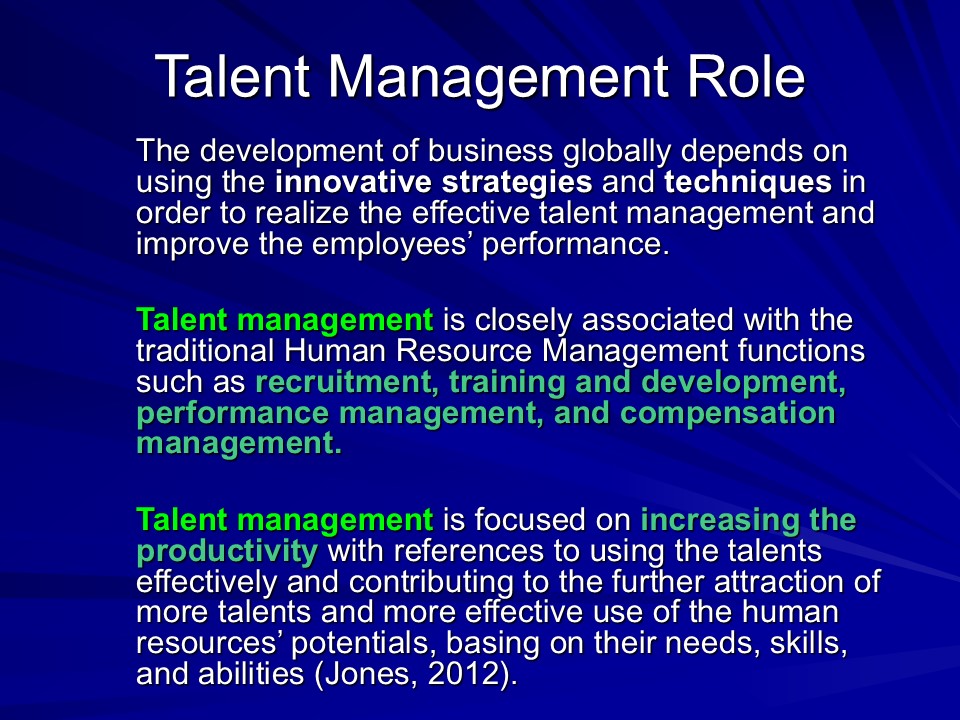
Talent Management Efforts and Systems
Effective talent management systems are based on using software applications designed to improve recruitment, training and development, performance management, and compensation management.
Functions of Talent Management Tools and Systems:
- to integrate recruitment procedures and retention in an system;
- to contribute to effective workforce planning;
- to document and record training and development procedures and received certification;
- to automate the registration for learning and training activities;
- to report on results and programmes completion;
- to search the system effectively (Mathis & Jackson, 2010).
Talent management software tools and systems are used to better manage the talents of the companies’ employees. The most popular and frequently purchased tools are
ICims, HRsmart, Halogen Talent Management, VanaHCM, SuccessFactors, and Bullhorn (Osterhaus, 2013).
The systems are used to recruit, screen, and manage the human resources in relation to their needs, talents, abilities, and performance.
These systems are based on utilizing the integrated strategies and techniques to manage the work and productivity of the human resources effectively.
The automated talent management tools are necessary to design and develop the effective methods to recruit and retain employees with references to the talents and companies’ needs and requirements.
Talent management tools and systems based on software applications can be divided into three categories:
Talent management software systems which help in organizing the recruitment process and the further performance evaluations with references to the employees’ successes (ICims; HRsmart);
Effective for focusing on the workforce planning, succession planning, and performance management (Halogen Talent Management; VanaHCM);
Developed for controlling the aspects of performance management and compensation management (SuccessFactors; Bullhorn) (Osterhaus, 2013).
Effective talent management systems are based on using software applications which are designed to improve such traditional HRM processes as recruitment, training and development, performance management, and compensation management.
Today, companies seek for tools which can help manage talents appropriately to contribute to the workforce productivity.
Modern talent management tools and systems are developed:
- to integrate recruitment procedures and retention in an system;
- to contribute to effective workforce planning;
- to document and record training and development procedures and received certification;
- to automate the registration for learning and training activities;
- to report on results and programmes completion;
- to search the system effectively.
A range of talent management software tools and systems are used to better manage the talents of the companies’ employees. The most popular and frequently purchased tools are ICims, HRsmart, Halogen Talent Management, VanaHCM, SuccessFactors, and Bullhorn (Osterhaus, 2013).
These talent management software systems are used to recruit, screen, and manage the human resources in relation to their needs, talents, abilities, and performance. These systems are based on utilizing the integrated strategies and techniques to manage the work and productivity of the human resources effectively. The automated talent management tools are necessary to design and develop the effective methods to recruit and retain employees with references to the talents and companies’ needs and requirements.
It is possible to divide talent management tools and systems based on software applications into three main categories:
- Talent management software systems which help in organizing the recruitment process and the further performance evaluations with references to the employees’ successes (ICims; HRsmart);
- Talent management software systems which are effective for focusing on the workforce planning, succession planning, and performance management (Halogen Talent Management; VanaHCM);
- Talent management software systems developed for controlling the aspects of performance management and compensation management (SuccessFactors; Bullhorn) (Osterhaus, 2013).
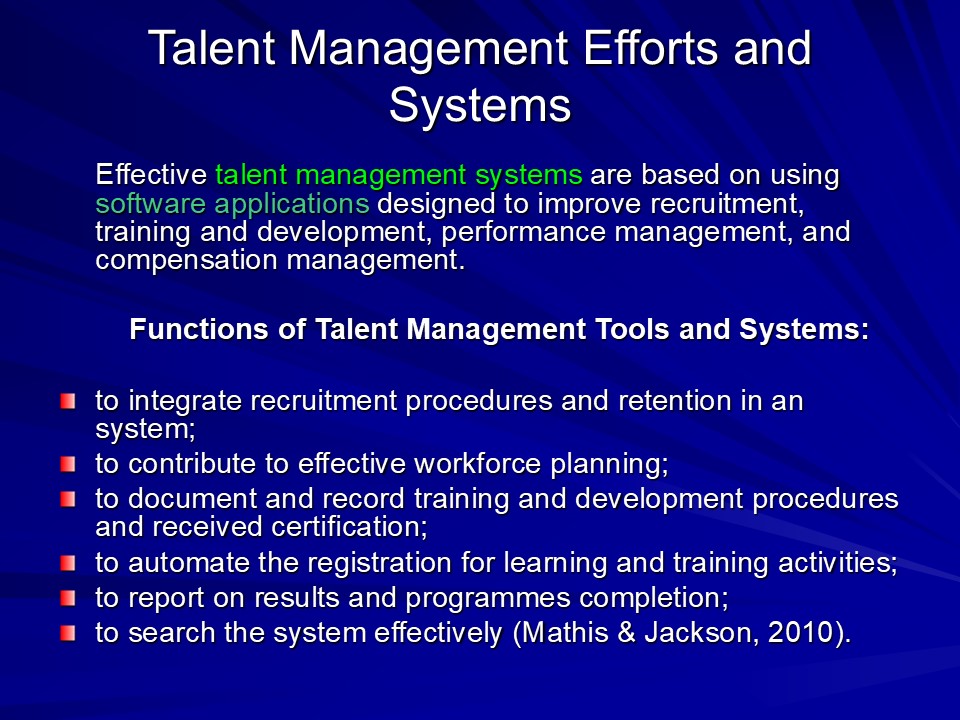
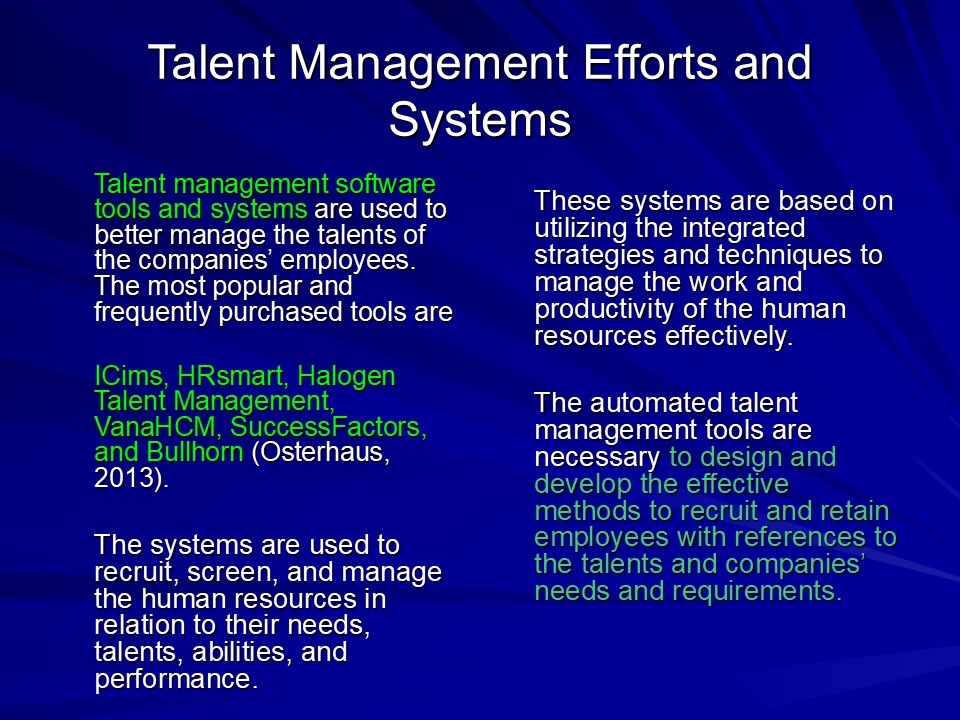
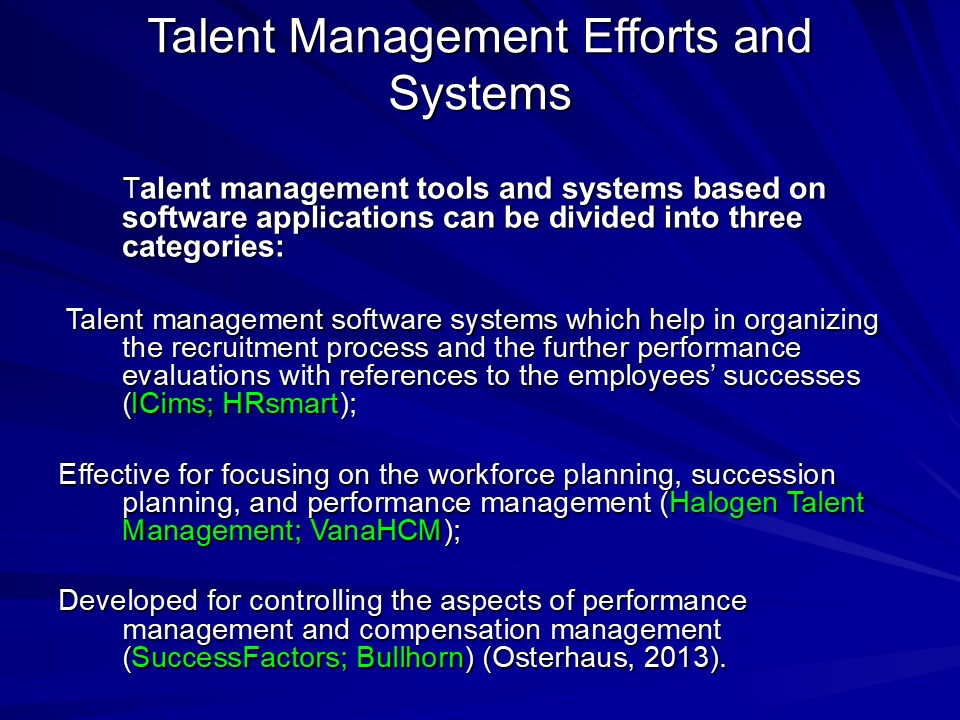
The Experience of Firms in Using the Talent Management Software
There is a global tendency to use the talent management tools and systems based on software applications instead of the traditional manual processes because of the advantages of the automated process.
Advantages of the Automated Process:
- the integration of the recruiting and retention processes;
- the focus on training, learning, and career development management with references to the planning and managing performance;
- the possibilities to recruit and screen applicants according to their talents and abilities fixed and recorded in the system;
- the opportunities to determine the potential the company has in relation to the talents and to predict the changes in performance or productivity;
- the possibilities to analyze the challenges associated with the company’s talents with the help of the automated system.
- Microsoft;
- Pepsi;
- Intel;
- Wal-Mart;
- Dell;
- SAS.
Focused on the advantages of using the talent management software and tools in order to optimize the talent management process according to the companies’ needs and interests (Sullivan, 2004).
Such firms as Microsoft, Pepsi, Intel, Wal-Mart, Dell, and SAS focused on the advantages of using the talent management software and tools in order to optimize the talent management process according to the companies’ needs and interests.
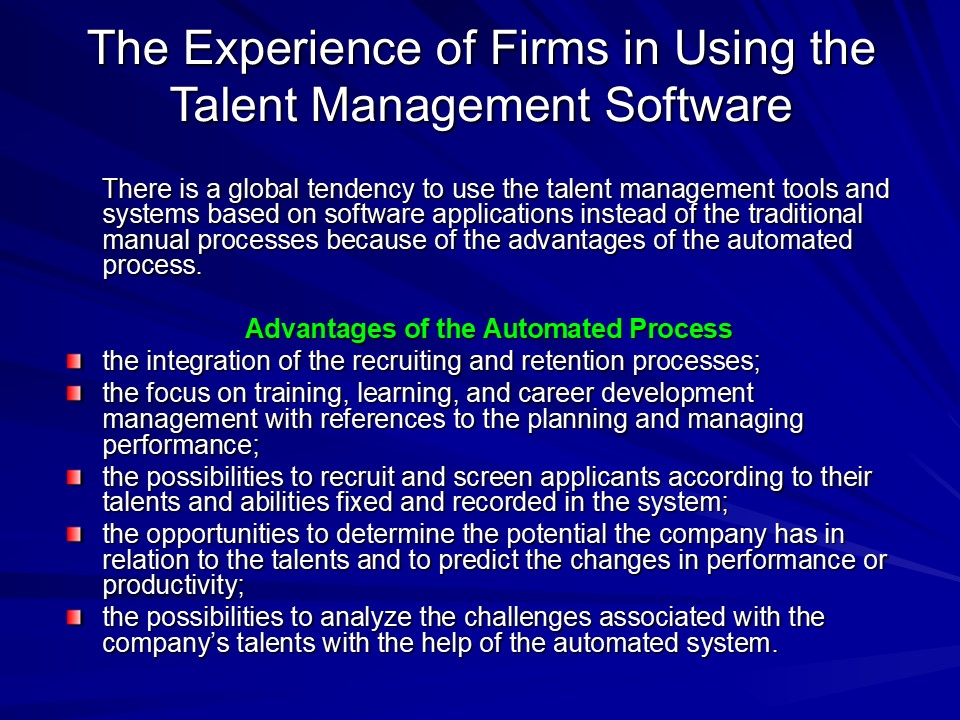
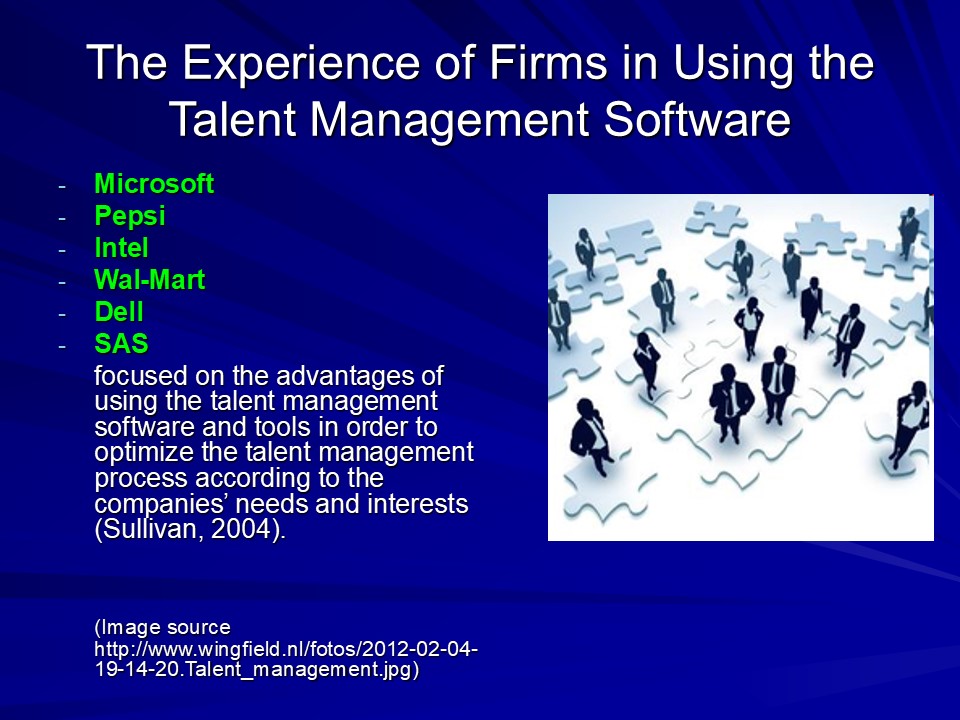
Talent Management Systems and Strategic Human Capital Management
The concept of ‘talent management’ is discussed as necessary and effective in order to stimulate the workforce productivity and improve performance of employees within the modern competitive industries.
The idea of talent management is closely connected with the goals of strategic human capital management.
The usage of talent management tools and systems based on software application is important not only to improve the processes of recruitment and training employees along with assessing their achievements but also for reforming the strategies of the human resource managers to hiring the staff and evaluating the employees’ productivity (Silzer, 2009).
The usage of the automated tools and systems contributes to development of more flexible working plans and schedules, performance and compensation management.
Human resource managers receive the opportunity to operate the information about the company’s talents according to the proposed and developed strategies effectively.
All the important facts are recorded with the help of new systems which make the strategic management more appropriate for the company’s needs (Mathis & Jackson, 2010).
The concept of ‘talent management’ is discussed as necessary and effective in order to stimulate the workforce productivity and improve performance of employees within the modern competitive industries.
From this point, the idea of talent management is closely connected with the goals of strategic human capital management. The usage of talent management tools and systems based on software application is important not only to improve the processes of recruitment and training employees along with assessing their achievements but also for reforming the strategies of the human resource managers to hiring the staff and evaluating the employees’ productivity.
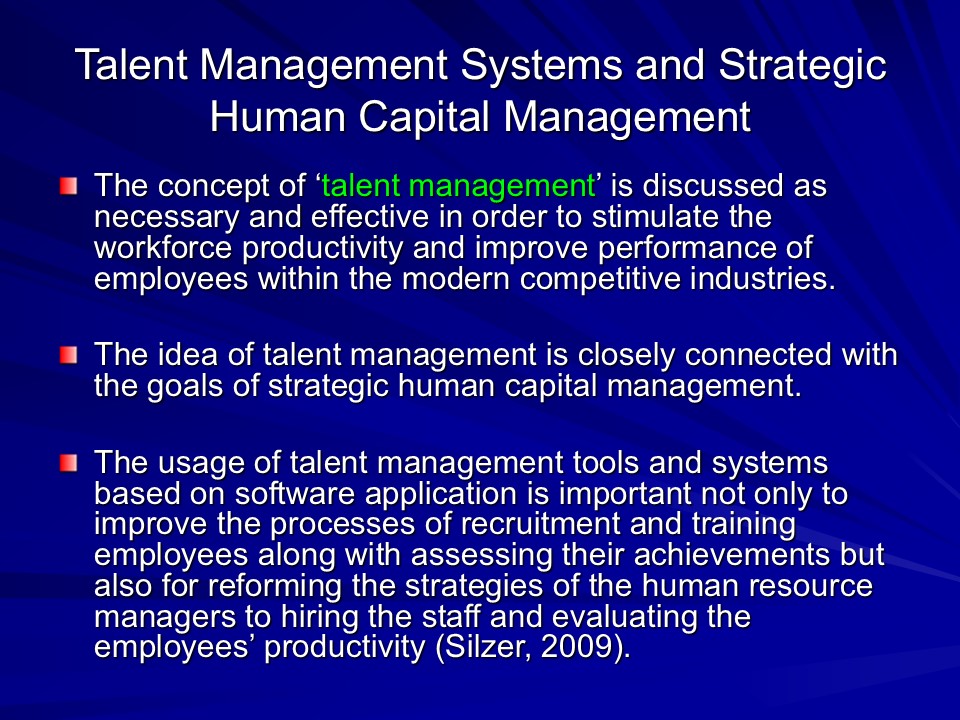
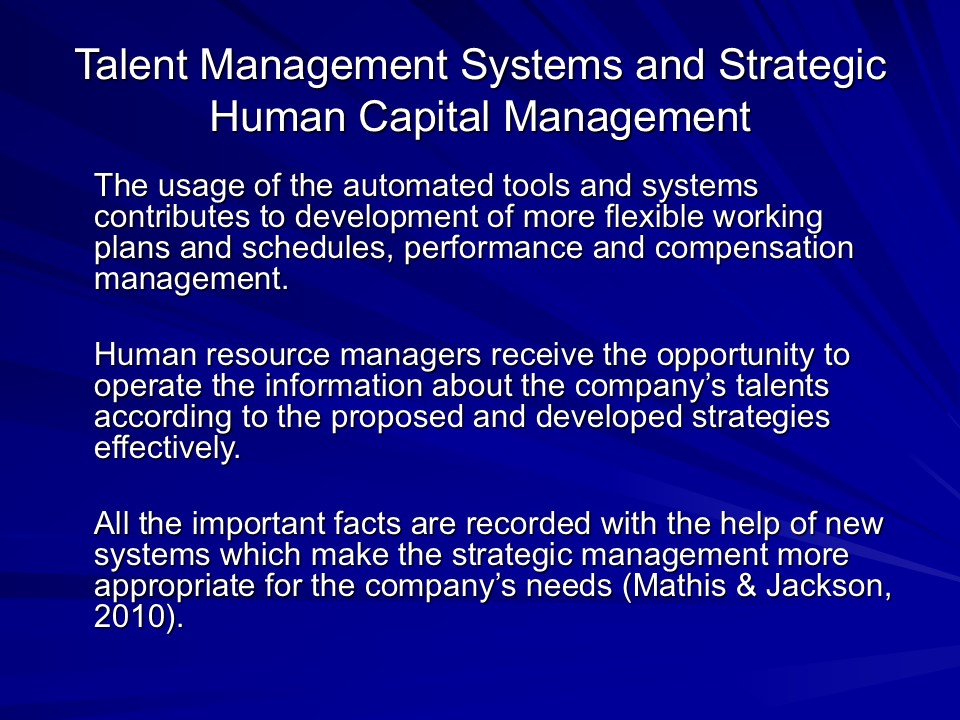
References
Jones, K. (2012). The user’s voice: Understanding the impact of talent management software. Web.
Mathis, R., & Jackson, J. (2010). Human resource management. USA: Cengage Learning.
Osterhaus, E. (2013). Compare Talent Management Software Systems. Web.
Silzer, R. (2009). Strategy-driven talent management: A leadership imperative. USA: John Wiley & Sons.
Sullivan, J. (2004). Talent Management defined: Is it a buzzword or a major breakthrough? Web.